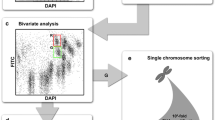Abstract
Three pea lines with reconstructed karyotypes were used for analysis and subsequent purification of individual chromosome types using flow cytometry and sorting. The lines JI 145, JI 146, and JI 148 possess defined chromosomal translocations allowing discrimination of three to four chromosome types from each line based on the different sizes of translocation chromosomes. Whereas only two chromosomes could be sorted from standard (wild-type) karyotype, a combined use of these lines allowed sorting of six out of the seven types of pea chromosomes. Chromosomes were identified and purity of flow-sorted fractions was assessed using fluorescence in-situ hybridization with a PisTR-B probe that was previously shown to give labelling patterns characteristic for each chromosome types. The fractions of flow-sorted chromosomes were of very high purity (> 95%) and proved to be suitable for detection of gene and marker sequences using PCR with specific primers. Three fractions containing chromosomes 27, 72 and a pool of all remaining chromosomes (1, 3, 4, 5, 6) flow-sorted from the line JI 148 were then used for PCR-based physical localization of genetic markers selected from linkage groups IV and VII. These experiments enabled assignment of the linkage groups IV and VII to chromosomes 4 and 7, respectively.
Similar content being viewed by others
References
Doležel J, Lucretti, S (1995) High-resolution flow karyotyping and chromosome sorting in Vicia faba lines with standard and reconstructed karyotypes. Theor Appl Genet 90: 797–802.
Doležel J, Lucretti S, Schubert I (1994) Plant chromosome analysis and sorting by flow cytometry. Crit Rev Plant Sci 13: 275–309.
Doležel J, Binarová P, Lucretti, S (1989) Analysis of nuclear DNA content in plant cells by flow cytometry. Biol Plant 31: 113–120.
Ellis THN, Lee D, Thomas CM et al. (1988) 5S ribosomal-RNA genes in Pisum – sequence, long-range and chromosomal organization. Mol Gen Genet 214: 333–342.
Ellis THN, Turner L, Hellens RP et al. (1992) Linkage maps in pea. Genetics 130: 649–663.
Ellis TH, Poyser SJ, Knox MR, Vershinin AV, Ambrose MJ (1998) Polymorphism of insertion sites of Ty1-copia class retrotransposons and its use for linkage and diversity analysis in pea. Mol. Gen. Genet. 260: 9–19.
Folkeson D (1990a) Assignment of linkage segments to chromosome 3 and 5 in Pisum sativum. Hereditas 112: 249–255.
Folkeson D (1990b) Assignment of linkage segments to the satellite chromosome-4 and chromosome-7 in Pisum sativum. Hereditas 112: 257–263.
Fuchs J, Kuhne M, Schubert I (1998) Assignment of linkage groups to pea chromosomes after karyotyping and gene mapping by fluorescent in situ hybridization. Chromosoma 107: 272–276.
Gilpin BJ, McCallum JA, Frew TJ, Timmerman-Vaughan GM (1997) A linkage map of the pea (Pisum sativum L) genome containing cloned sequences of known function and expressed sequence tags (ESTs). Theor Appl Genet 95: 1289–1299.
Gualberti G, Doležel J, Macas J, Lucretti S (1996) Preparation of pea (Pisum sativum L) chromosome and nucleus suspensions from single root-tips. Theor Appl Genet 92: 744–751.
Hall KJ, Parker JS, Ellis THN (1997a) The relationship between genetic and cytogenetic maps of pea. I. Standard and translocation karyotypes. Genome 40: 744–754.
Hall KJ, Parker JS, Ellis THN et al. (1997b) The relationship between genetic and cytogenetic maps of pea. II. Physical maps of linkage mapping populations. Genome 40: 755–769.
Houben A, Wanner G, Hanson L, Verlin D, Leach CR, Timmis JN (2000) Cloning and characterisation of polymorphic heterochromatic segments of Brachycome dichromosomatica. Chromosoma 109: 206–213.
Klein HD (1973) The karyotypes of Pisum sativum ‘dippes gelbe viktoria’, and two translocations involving the satellite chromosomes. Pisum Newslett 5: 20–21.
Lamm R (1983) Cytological studies of L-108, Nilsson's NII. Pisum Newslett 15: 33–35.
Lamm R (1987) Comments on the chromosome maps of Pisum sativum. Pisum Newslett 19: 20–23.
Laucou V, Haurogné K, Ellis N, Rameau C (1998) Genetic mapping in pea. 1. RAPD-based genetic linkage map of Pisum sativum. Theor Appl Genet 97: 905–915.
Leitch AR, Schwarzacher T, Jackson D, Leitch IJ (1994) In situ hybridization. BIOS Scientific Publishers Ltd., Oxford.
Lucretti S, Doležel J, Schubert I, Fuchs J (1993) Flow karyotyping and sorting of Vicia faba chromosomes. Theor Appl Genet 85: 665–672.
Lysák MA, Číhalíková J, Kubaláková M, Šimková H, Kunzel G, Doležel J (1999) Flow karyotyping and sorting of mitotic chromosomes of barley (Hordeum vulgare L.). Chromosome Res 7: 431–444.
Macas J, Doležel J, Lucretti S et al. (1993) Localization of seed protein genes on flow-sorted field bean chromosomes. Chromosome Res 1: 107–115.
Mendel G (1866) Versuche über Pflanzenhybriden. Verhandl Naturf Ver Brünn 4: 3–47.
Neumann P, Lysák M, Doležel J, Macas J (1998) Isolation of chromosomes from Pisum sativum L. hairy root cultures and their analysis by flow cytometry. Plant Sci 137: 205–215.
Neumann P, Nouzová M, Macas J (2001) Molecular and cytogenetic analysis of repetitive DNA in pea (Pisum sativum L.). Genome 44: 716–728.
Simpson PR, Newman MA, Davies DR, Ellis THN, Matthews PM, Lee D (1990) Identification of translocations in pea by in situ hybridization with chromosome-specific DNA probes. Genome 33: 745–749.
Shibata F, Hizume M, Kuroki Y (2000) Molecular cytogenetic analysis of supernumerary heterochromatic segments in Rumex acetosa. Genome 43: 391–397.
Weeden NF, Marx GA (1987) Further genetic analysis and linkage relationships of isozyme loci in the pea. Confirmation of the diploid nature of the genome. J Hered 78: 153–159.
Weeden NF, Swiecicki WK, Timmerman-Vaughan GM, Ellis THN, Ambrose M (1996) The current pea linkage map. Pisum Genet 28: 1–4.
Weeden NF, Ellis THN, Timmerman-Vaughan GM, Swiecicki WK, Rozov SM, Berdnikov VA (1998) A consensus linkage map for Pisum sativum. Pisum Genet 30: 1–4.
Author information
Authors and Affiliations
Rights and permissions
About this article
Cite this article
Neumann, P., Pozárková, D., Vrána, J. et al. Chromosome Sorting and PCR-Based Physical Mapping in Pea (Pisum Sativum L.). Chromosome Res 10, 63–71 (2002). https://doi.org/10.1023/A:1014274328269
Issue Date:
DOI: https://doi.org/10.1023/A:1014274328269




